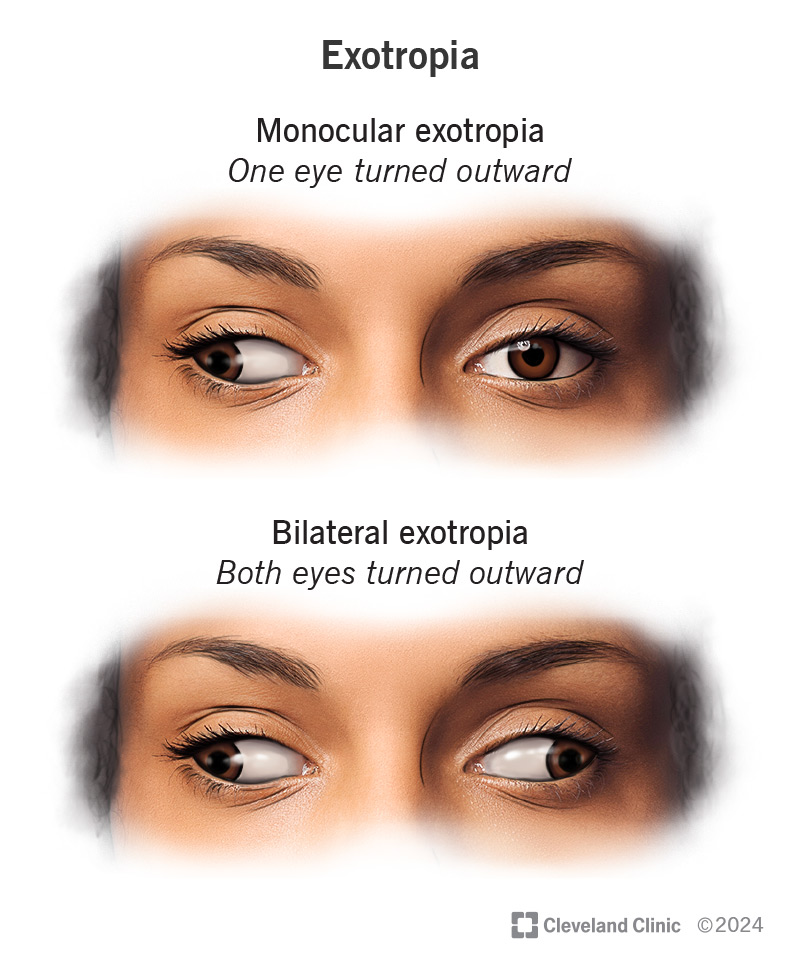Exotropia, or eyes that turn outward, is a form of strabismus (eye misalignment). There are various forms of exotropia. It’s best to treat all types of eye misalignment as early as possible.
Advertisement
Cleveland Clinic is a non-profit academic medical center. Advertising on our site helps support our mission. We do not endorse non-Cleveland Clinic products or services. Policy

Exotropia is a form of strabismus, a misalignment of the eyes. If you have exotropia, one or both of your eyes turn outward (toward your ears). In monocular exotropia, the turning involves one eye. In bilateral exotropia, the turning affects both eyes.
Advertisement
Cleveland Clinic is a non-profit academic medical center. Advertising on our site helps support our mission. We do not endorse non-Cleveland Clinic products or services. Policy
Exotropia (pronounced “ek-suh-TROH-pee-uh”) is the opposite of esotropia, the turning inward of your eyes. While it’s commonly seen in babies and children, it can also affect adults.
If you notice your child’s eye turning out, it’s important to seek treatment right away. The eye with exotropia can have vision problems and the appearance of the condition can lead to low self-esteem and issues with social development. The sooner your child receives a diagnosis, the sooner they can begin treatment to correct the alignment of their eyes.
There are many types of exotropia, including:
Advertisement
The signs and symptoms of exotropia include:
Exotropia has many possible causes, including:
Exotropia, especially intermittent exotropia, sometimes has no known cause.
The risk factors for developing exotropia include:
Left untreated, intermittent exotropia can progress to constant exotropia. As the condition progresses at a young age, your child may experience amblyopia or the loss of binocular vision (both eyes working together to see).
You or your healthcare provider may notice that your child’s eyes are turning outward. (It’s not always obvious to the person who has exotropia.) They may refer you to an ophthalmologist or optometrist.
Your child’s provider will ask for a family and medical history and will perform an eye exam. The exam will cover how your child’s eyes move and focus. Testing may include:
Treatment of exotropia varies depending on the severity of the condition. Sometimes, intermittent exotropia stays mild or goes away on its own. Treatment options include:
Advertisement
Exotropia may become less frequent over time, but most types don’t resolve completely. Treatment with nonsurgical measures may help control the condition, but many people still experience recurrences.
You can’t prevent exotropia. If you’re pregnant or planning to become pregnant, you may wish to speak with a genetic counselor about your risk of passing on the condition to your child.
Always contact your child’s healthcare provider if they have any symptoms that worry you. This includes signs and symptoms like:
Questions you may want to ask your child’s provider include:
Untreated exotropia can lead to amblyopia, poor vision in one eye. Without treatment, you may lose your ability to see with both eyes (binocular vision) and have difficulty with your depth perception.
Exotropia tends to get worse over time if it’s not treated. You can manage it, but it may never go completely away. Some researchers believe that the permanent answer to the problem of intermittent exotropia lies in being able to repair the brain, which isn’t currently possible.
Advertisement
If your child has exotropia, the condition can affect their self-esteem and may make relationships difficult to form or maintain. When someone doesn’t make eye contact, it may appear that they’re not paying attention or distracted. That’s why it’s important to talk to an eye care specialist as soon as you notice the issue. In children, it’s important to have an eye exam to make sure each eye is healthy and seeing well. While you can’t prevent it from happening, you can act quickly to seek treatment.
Advertisement
Getting an annual eye exam at Cleveland Clinic can help you catch vision problems early and keep your eyes healthy for years to come.

Last reviewed on 10/30/2024.
Learn more about the Health Library and our editorial process.